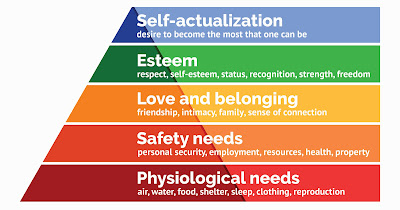Maslow's Hierarchy of Needs & Self-Care
"Physiological needs: The first of the id-driven lower needs on Maslow's hierarchy are physiological needs. These most basic human survival needs include food and water, sufficient rest, clothing and shelter, overall health, and reproduction. Maslow states that these basic physiological needs must be addressed before humans move on to the next level of fulfillment.
Safety needs: Next among the lower-level needs is safety. Safety needs include protection from violence and theft, emotional stability and well-being, health security, and financial security.
Love and belonging needs: The social needs on the third level of Maslow’s hierarchy relate to human interaction and are the last of the so-called lower needs. Among these needs are friendships and family bonds—both with biological family (parents, siblings, children) and chosen family (spouses and partners). Physical and emotional intimacy ranging from sexual relationships to intimate emotional bonds are important to achieving a feeling of elevated kinship. Additionally, membership in social groups contributes to meeting this need, from belonging to a team of coworkers to forging an identity in a union, club, or group of hobbyists.
Esteem needs: The higher needs, beginning with esteem, are ego-driven needs. The primary elements of esteem are self-respect (the belief that you are valuable and deserving of dignity) and self-esteem (confidence in your potential for personal growth and accomplishments). Maslow specifically notes that self-esteem can be broken into two types: esteem which is based on respect and acknowledgment from others, and esteem which is based on your own self-assessment. Self-confidence and independence stem from this latter type of self-esteem.
Self-actualization needs: Self-actualization describes the fulfillment of your full potential as a person. Sometimes called self-fulfillment needs, self-actualization needs occupy the highest spot on Maslow's pyramid. Self-actualization needs include education, skill development—the refining of talents in areas such as music, athletics, design, cooking, and gardening—caring for others, and broader goals like learning a new language, traveling to new places, and winning awards."
"Using Abraham H. Maslow’s (1943) easily recognized and well-established theory of motivation, we can design our own individualized self-care plans. By pausing a few times each day in order to check in on how we’re doing, we can ask ourselves the following questions associated with each level of Maslow’s hierarchy in order to identify what we need in that very moment.
The Levels of Maslow’s Hierarchy of Needs
- Physiological: Are my basic needs met?
- Safety: Do I feel safe?
- Belonging: Do I belong?
- Esteem: Do I feel confident?
- Self-Actualization: Am I living my best life?
- Transcendence: Do I feel inspired?
Strategies Aligned to Maslow’s Hierarchy of Needs
- Physiological: Drink water, take a walk, get a good night’s sleep
- Safety: Stick to a schedule, listen to calming music
- Belonging: Put dates with your friends and family in your calendar, share meals without distractions
- Esteem: Utilize a growth mindset, talk to yourself like you’d talk to a loved one
- Self-Actualization: Choose work you love, challenge yourself with personal goals
- Transcendence: Practice gratitude, engage in altruistic acts






.png)



.png)




.png)


0 Comentarios